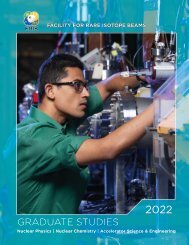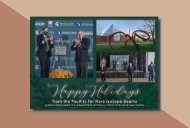2021FRIB/NSCL Graduate Brochure
You also want an ePaper? Increase the reach of your titles
YUMPU automatically turns print PDFs into web optimized ePapers that Google loves.
Dean Lee<br />
Professor of Physics<br />
Theoretical Nuclear Physics<br />
Selected Publications<br />
D. Frame, R. He, I. Ipsen, Da. Lee, De. Lee, E.<br />
Rrapaj, “Eigenvector continuation with subspace<br />
learning”, Phys. Rev. Lett. 121, 032501 (2018).<br />
S. Elhatisari et al., “Nuclear binding near a<br />
quantum phase transition,” Phys. Rev. Lett. 117,<br />
no. 13, 132501 (2016).<br />
PhD, Physics, Harvard<br />
University, 1998<br />
Joined FRIB in<br />
August 2017<br />
leed@frib.msu.edu<br />
S. Elhatisari, D. Lee, G. Rupak, E. Epelbaum, H.<br />
Krebs, T. A. Lähde, T. Luu and U.-G. Meißner,<br />
“Ab initio alpha-alpha scattering,” Nature 528,<br />
111 (2015).<br />
E. Epelbaum, H. Krebs, T. A. Lähde, D. Lee and<br />
U.- G. Meißner, “Viability of Carbon-Based Life<br />
as a Function of the Light Quark Mass,” Phys.<br />
Rev. Lett. 110, no. 11, 112502 (2013).<br />
E. Epelbaum, H. Krebs, T. A. Lähde, D. Lee<br />
and U.-G. Meißner, “Structure and rotations of<br />
the Hoyle state,” Phys. Rev. Lett. 109, 252501<br />
(2012).<br />
How do we connect fundamental physics to forefront<br />
experiments?<br />
With new science waiting to be discovered at the Facility for<br />
Rare Isotope Beams (FRIB) and the dawning of the era of<br />
exascale supercomputing, this is a profound challenge and<br />
opportunity for nuclear theory. The Lee Research Group<br />
works to understand the nature and origins of matter by<br />
crafting new approaches that link quantum chromodynamics<br />
and electroweak theory to precise predictions for nuclear<br />
structure and reactions relevant to the FRIB science mission.<br />
One of the methods we have developed with collaborators<br />
is lattice effective field theory. Effective field theory (EFT)<br />
is an organizing principle for the interactions of a complex<br />
system at low energies. When applied to low-energy<br />
protons and neutrons in a formulation called chiral effective<br />
field theory, it functions as an expansion in powers of the<br />
nucleon momenta and the pion mass. Lattice EFT combines<br />
this theoretical framework with lattice methods and Monte<br />
Carlo algorithms that are applicable to few-body systems,<br />
heavier nuclei, and infinite matter. The Lee Research Group<br />
is part of the Nuclear Lattice EFT Collaboration, which has<br />
been pioneered many of the theoretical ideas and methods<br />
now being used in nuclear lattice simulations.<br />
Nuclear lattice simulations<br />
Some of the topics we are studying are superfluidity, nuclear<br />
clustering, nuclear structure from first principles calculations,<br />
ab initio scattering and inelastic reactions, thermodynamics<br />
and phases of nuclear matter, and properties of nuclei as<br />
seen through electroweak probes.<br />
We are also applying new technologies and computational<br />
paradigms such as eigenvector continuation, machine<br />
learning tools to find hidden correlations, and quantum<br />
computing algorithms for the nuclear many-body problem.<br />
We are looking to work with experimentalists and theorists<br />
on new ideas and creative ways to collaborate. If you are<br />
interested in working in or with our group, please email<br />
leed@frib.msu.edu.<br />
40<br />
KEYWORDS<br />
Eigenvector continuation<br />
Nuclear Structure | Nuclear Reactions | Many-Body<br />
Theory | Superfluidity | Quantum Computing






